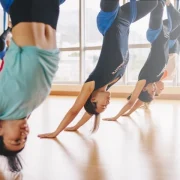
Singapore’s vibrant fitness culture has seen a surge in strength training, high-intensity interval workouts, spin classes, and endurance sports. However, amidst all this intensity, recovery is often overlooked—leading to muscle fatigue, injury, and plateaued progress. That’s where aerial yoga comes in. While widely known for its graceful, acrobatic poses, aerial yoga has another side: it is an effective tool for active recovery.
For athletes and everyday gym-goers, active recovery plays a critical role in long-term performance. Unlike complete rest, active recovery involves low-impact movement that enhances circulation, promotes healing, and gently stretches tired muscles. Aerial yoga provides all these benefits and more—making it a smart addition to any training plan in Singapore.
If you train regularly and want to avoid burnout, reduce soreness, and stay injury-free, it’s time to explore how aerial yoga supports recovery in a way that’s enjoyable, restorative, and sustainable. Studios like Yoga Edition offer aerial yoga classes suited for every fitness level, including those seeking muscle restoration after heavy workouts.
Understanding Active Recovery: Why It Matters
Before diving into how aerial yoga helps, it’s important to understand what active recovery is. Unlike passive recovery (which involves complete rest), active recovery refers to light physical activity that keeps the body moving while promoting muscle repair and reducing soreness.
Some common features of active recovery include:
- Gentle stretching to reduce tension
- Low-intensity movement to stimulate blood flow
- Breathing techniques to lower cortisol
- Improved lymphatic drainage for waste removal
When you add aerial yoga to your recovery routine, you engage in all of the above in a single, low-impact session—enhancing the body’s natural repair processes while still moving with intention.
How Aerial Yoga Enhances Recovery for Fitness Enthusiasts
1. Promotes Circulation and Muscle Oxygenation
Aerial yoga involves slow, deliberate transitions and inversions that elevate the legs and decompress the spine. These positions increase blood circulation, especially to muscles that may feel tight or inflamed from training.
Inversions help:
- Improve venous return to the heart
- Deliver fresh oxygen to fatigued tissues
- Drain lactic acid buildup
This process accelerates healing, reduces muscle soreness (DOMS), and keeps joints and soft tissue in healthier condition—essential for people training multiple times per week.
2. Reduces Muscle Tension and Prevents Stiffness
Whether it’s weightlifting, running, or spin, high-intensity training often results in micro-tears and tightness across major muscle groups. Aerial yoga allows athletes to stretch out deeply without compressing joints or overloading the body.
Key benefits include:
- Passive lengthening of muscles through supported poses
- Myofascial release through gentle swaying and pressure
- Improved flexibility, preventing post-workout stiffness
Common target areas like the hamstrings, shoulders, hip flexors, and lower back benefit greatly from aerial yoga’s dynamic stretch patterns.
3. Facilitates Spinal Decompression and Postural Reset
Many exercises—from squats to bench presses—involve spinal loading. Over time, this can compress discs and lead to lower back strain. Aerial yoga’s supported inversions help undo this compression by gently elongating the spine.
This is especially valuable for:
- Weightlifters
- Runners and cyclists with forward-leaning posture
- Desk workers with poor postural alignment
The hammock acts as a traction device that allows gravity to create space between vertebrae without force, reducing back tension and improving posture.
4. Supports Mental Recovery and Cortisol Reduction
Recovery isn’t only physical—it’s mental. After intense training, adrenaline and cortisol levels can remain elevated, preventing full recovery. Aerial yoga’s emphasis on breath control and slow, mindful movement activates the parasympathetic nervous system, allowing the body to shift into a state of rest and repair.
Benefits include:
- Lowered stress hormones
- Improved sleep quality
- Faster nervous system reset between training days
For Singaporeans balancing work, workouts, and lifestyle stress, this mental recharge is just as vital as muscle repair.
5. Enhances Body Awareness and Injury Prevention
In high-intensity training, repetitive motion and speed can lead to imbalances and unnoticed compensation patterns. Aerial yoga forces practitioners to slow down and engage stabiliser muscles, improving proprioception and joint awareness.
This leads to:
- Better neuromuscular coordination
- Early detection of imbalances or weaknesses
- Lower risk of overuse injuries
Athletes who incorporate aerial yoga into their weekly schedule often report increased control and fewer minor strains or pulls during training.
Recommended Aerial Yoga Poses for Recovery
Here are a few beginner-friendly poses that are especially effective for post-workout recovery:
Floating Pigeon Pose
Cradles one leg in the hammock while the other extends back
- Stretches glutes and hips
- Releases piriformis tension
- Eases lower back strain
Hammock-supported Forward Fold
Hips in the hammock with upper body hanging toward the floor
- Targets hamstrings and calves
- Relieves lumbar tightness
- Improves hamstring length without compression
Restorative Inverted Butterfly
Suspended upside down with soles of the feet together
- Promotes spinal decompression
- Stimulates blood flow to the brain
- Encourages nervous system reset
Savasana in the Hammock
Final resting pose fully supported by fabric
- Induces deep relaxation
- Allows complete muscle release
- Supports mental integration and clarity
These movements are gentle but effective—ideal for anyone experiencing post-exercise tightness, fatigue, or tension.
How to Integrate Aerial Yoga into Your Training Plan
You don’t need to replace your regular workout sessions. Instead, use aerial yoga as a complementary tool to support longevity and performance.
Here’s how to structure it:
- Once a week: Use aerial yoga as your primary recovery session
- After intense training days: Attend an evening class to support muscle repair
- Rest weeks: Use aerial yoga exclusively to allow full-body reset
- Deload phases: Pair it with mobility or breathing practices
It’s especially helpful before major events (marathons, competitions) or after injury rehab, offering gentle mobility while staying active.
Who in Singapore Benefits Most from Aerial Recovery?
This practice is well-suited for:
- Runners, cyclists, and triathletes
- Weightlifters and gym users
- HIIT and spin class enthusiasts
- Dancers and martial artists
- Anyone training 3+ times a week
Even casual fitness participants who experience tightness or soreness will gain something from a weekly aerial yoga recovery session.
Real-Life FAQ: Aerial Yoga for Athletes and Recovery
Is aerial yoga too gentle to count as recovery for intense training?
Not at all. While it’s low impact, aerial yoga is deeply restorative. It addresses fascia, joints, and circulation in a way that traditional cooldowns often miss.
Can I do aerial yoga on the same day as strength training?
Yes. It works well as an evening practice to unwind after morning or afternoon workouts. Just avoid doing it right after eating or during deep muscle soreness on Day 1 of DOMS.
What if I’m not flexible? Will recovery poses still help?
Definitely. Aerial yoga is designed for all bodies. You don’t need flexibility to benefit from the recovery elements—just a willingness to breathe and release tension.
Will it help prevent injuries?
Yes. Aerial yoga improves alignment, muscle balance, and joint mobility, all of which reduce your risk of injuries caused by tightness, poor posture, or overtraining.
Do I need prior yoga experience to try aerial recovery classes?
No experience is needed. In fact, many athletes who dislike traditional yoga find aerial yoga more approachable and enjoyable.











